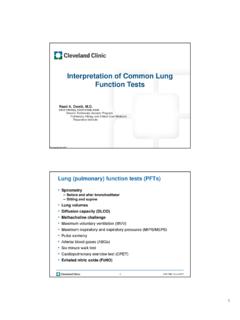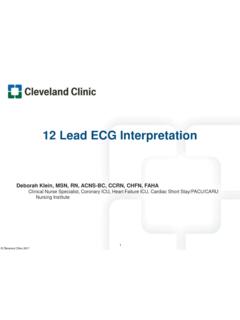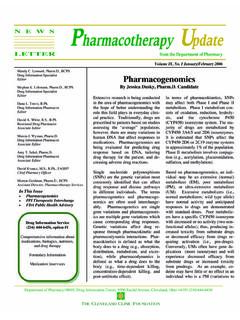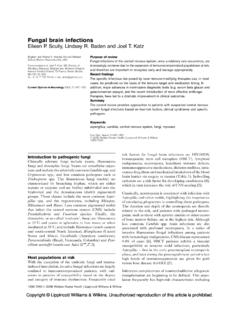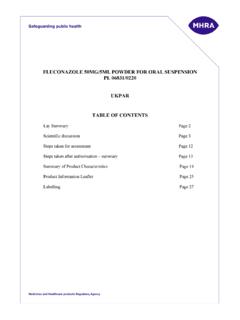Transcription of Guidelines for Antimicrobial Usage
1 Guidelines for Antimicrobial Usage 2012-2013. CVR(AMUG13).indd 1 8/15/2012 1:48:57 PM. Guidelines for Antimicrobial Usage 2012-2013. 1 8/15/2012 2:53:48 PM. Copyright 2012. Cleveland Clinic Published by: Professional Communications, Inc. All rights reserved. No part of this publication may be reproduced or transmitted in any form or by any means, electronic or mechanical, including photocopy, recording or any other information storage and retrieval system, without the prior agreement and written permission of the publisher. 400 Center Bay Drive PO Box 10. West Islip, NY 11795 For orders only, please call: Caddo, OK 74729-0010. (t) 631/661-2852. (f) 631/661-2167 1-800-337-9838 (t) 580/367-9838. (f) 580/367-9989. ISBN: 978-1-932610-85-7. Printed in Mexico DISCLAIMER. The opinions expressed in this publication reflect those of the authors.
2 However, the authors make no warranty regarding the contents of the publication. The protocols described herein are general and may not apply to a specific patient. Any product mentioned in this publication should be taken in accordance with the prescribing information provided by the manufacturer. This text is printed on recycled paper. 2 8/15/2012 2:54:01 PM. Committee Susan J. Rehm, MD Jennifer K. Sekeres, PharmD. Department of Infectious Disease Elizabeth Neuner, PharmD. Department of Pharmacy Department of Infectious Disease Department of Clinical Pathology J. Walton Tomford, MD Gerri S. Hall, PhD. Carlos M. Isada, MD Belinda Yen-Lieberman, PhD. Steven M. Gordon, MD Susan Harrington, PhD. Steven K. Schmitt, MD Sandra Richter, MD. Steven D. Mawhorter, MD Gary Procop, MD. Sherif B. Mossad, MD Department of Pediatrics Alan J.
3 Taege, MD. Johanna Goldfarb, MD. Kristin Englund, MD. Camille Sabella, MD. Thomas G. Fraser, MD. Lara Danzinger-Isakov, MD. Marisa Tungsiripat, MD. Charles Foster, MD. Lucileia Johnson, MD. David van Duin, MD Department of Pharmacy Cyndee Miranda, MD Marc Earl, PharmD. Ume Abbas, MD Jodie M. Fink, PharmD. Adarsh Bhimraj, MD. Tricia Bravo, MD. Eric Cober, MD. Dalia El-Bejjani, MD. Christine Koval, MD. 3 8/15/2012 2:54:01 PM. Introduction T he majority of hospitalized patients receive antimicrobials for therapy or prophylaxis during their inpatient stay. It has been estimated that at least fty percent of patients receive antimicrobials needlessly. Reasons include inappropriate prescribing for Antimicrobial prophylaxis, continuation of empiric therapy despite negative cultures in a stable patient, and a lack of awareness of susceptibility patterns of common pathogens.
4 Over prescribing not only increases the costs of health care, but may result in superinfection due to Antimicrobial -resistant bacteria, as well as opportunistic fungi, and may increase the likelihood of an adverse drug reaction. On the other hand, not prescribing (when there is an urgent need at the bedside) may also lead to serious consequences. The materials in this booklet constitute Guidelines only and are subject to change pursuant to medical judgement relative to individual patient needs. Our Antimicrobial formulary decisions are made annually after thorough deliberations and consensus building with members of the Infectious Disease Department, the Department of Pharmacy, and the Section of Microbiology. In vitro susceptibility data of the previous year are shared and emerging resistance patterns reviewed.
5 Usage and cost data are discussed. The mission of our program is to provide the most cost-effective Antimicrobial agents to our patients. This booklet does not contain speci c Guidelines for treatment of human immunode - ciency virus (HIV) infection. Nor is prophylaxis against opportunistic microorganisms included, since such issues are usually handled in our outpatient clinics. Similarly, treatment of infectious diseases commonly seen in the outpatient setting, such as otitis media and pharyngitis, are not included in this booklet. 4 8/15/2012 2:54:01 PM. TABLE 1 Typical Gram Stain Morphology of Selected Organisms1. Gram-Positive Cocci (GPC) Gram-Negative Cocci (GNC). Clusters: Diplococci Staphylococcus sp Pairs: Pairs, chains: Neisseria meningitidis Streptococcus sp Neisseria gonorrhoeae Enterococcus sp Moraxella catarrhalis Peptostreptococcus sp (anaerobe) Other: Acinetobacter sp (coccobacilli).
6 Gram-Positive Bacilli (GPB). Irregular: Gram-Negative Bacilli (GNB). Diphtheroid: Enterobacteriaceae: Corynebacterium sp Escherichia coli Propionibacterium sp (anaerobe) Serratia sp Large, with spores: Klebsiella sp Clostridium sp (anaerobe) Enterobacter sp Bacillus sp Citrobacter sp Branching, beaded, rods: Nonfermentative: Nocardia sp Pseudomonas aeruginosa Actinomyces sp (anaerobe) Stenotrophomonas maltophilia Other: Many others Listeria monocytogenes (blood/cerebrospinal fluid) Haemophilus influenzae (coccobacilli). Lactobacillus sp (vaginal/blood) Bacteroides fragilis group (anaerobe). Fusiform (long, pointed): Fusobacterium sp (anaerobe). Capnocytophaga sp 1 These organisms represent a subset of possible identi cations correlating with gram stain morphology observed on direct specimen preparations.
7 Correlation with culture, specimen quality, and clinical ndings is required. 5. 5 8/15/2012 2:54:01 PM. TABLE 2 Key Characteristics of Selected Organisms Gram-Positive Cocci (GPC) Gram-Negative Cocci (GNC). Catalase-positive: Neisseria meningitidis Staphylococcus sp Neisseria gonorrhoeae Catalase-negative: Moraxella catarrhalis Enterococcus sp Acinetobacter sp1. Streptococcus sp (chains). Coagulase-positive: Gram-Negative Bacilli (GNB). Staphylococcus aureus Lactose-positive: Coagulase-negative: Escherichia coli Coagulase-negative staphylococci (CNS): Klebsiella pneumoniae (mucoid). Blood: Staphylococcus epidermidis or CNS Enterobacter sp2. Urine: Staphylococcus saprophyticus Citrobacter sp2. Staphylococcus lugdunensis4 Lactose-negative/oxidase-negative: Proteus mirabilis: indole-negative Gram-Positive Bacilli (GPB) Proteus vulgaris: indole-positive Diphtheroids: Providencia sp May be Corynebacterium sp: can be blood culture Morganella morganii contaminants Serratia sp3.
8 Corynebacterium jeikeium, Corynebacterium Salmonella sp striatum, Corynebacterium amycolatum: resistant Shigella sp to many agents except vancomycin Acinetobacter sp1. Anaerobic diphtheroids: Propionibacterium acnes Stenotrophomonas (Xanthomonas) maltophilia usually susceptible to beta-lactams and vancomycin (nonfermenter). Bacillus sp: Bacillus anthracis: non-motile and non-E- Lactose-negative/oxidase-positive: hemolytic; Bacillus cereus; Bacillus subtilis, ie, large, Pseudomonas aeruginosa (green; grape odor ). box car rods with spores Aeromonas hydrophila (may be lactose-positive). Listeria monocytogenes: cerebrospinal fluid, blood Rare: Lactobacillus sp: vaginal flora, rarely in blood Other Pseudomonas sp Nocardia sp: Branching, beaded; partial acid fast- Moraxella sp1. positive Alcaligenes sp Rapidly growing mycobacteria: Burkholderia sp Mycobacterium fortuitum Mycobacterium chelonae/abscessus, Mycobacterium mycogenicum (Table continued on following page) 6.
9 6 8/15/2012 2:54:01 PM. TABLE 2 Key Characteristics of Selected Organisms (continued). Gram-Negative Bacilli (GNB) Thermally dimorphic (yeast in tissue, mold in lab): Other: Histoplasma capsulatum (slow growing). Haemophilus influenzae (coccobacillary); requires Blastomyces dermatitidis supplements/special media (chocolate agar plate) Coccidioides immitis Fungi Yeast: Molds: Candida sp; Candida albicans if germ tube-positive Aseptate hyphae: Cryptococcus sp (no pseudohyphae);. Zygomycetes, such as: Cryptococcus neoformans if latex- or CAD-positive Rhizopus sp Candida glabrata Mucor Trichosporon sp Septate hyphae: Rhodotorula, Saccharomyces sp Brown pigment (phaeohyphomycetes), such as: Bipolaris sp Anaerobes Exserohilum sp GNB: Alternaria sp Bacteroides sp (Bacteroides fragilis). Curvularia sp Fusobacterium sp Sporothrix schenckii ( rose-gardeners ) GNC: Non-brown pigmented (hyalohyphomycetes, Veillonella sp most common), such as: GPC: Aspergillus sp (Aspergillus fumigatus, Peptostreptococcus sp Aspergillus flavus) GPB: Fusarium sp Propionibacterium acnes Penicillium sp Clostridium sp (spores).
10 Paecilomyces sp Actinomyces sp (branching, filamentous). Dermatophytes Lactobacillus sp Eubacterium sp 1 May be either bacillary or coccoid. Bifidobacterium sp 2 May be lactose negative. 3 May produce red pigment and appear lactose-positive initially. 4 Clinically can act as Staphylococcus aureus. 7. 7 8/15/2012 2:54:01 PM. TABLE 3 Usual Acid-Fast Bacillus Characteristics Mycobacterium sp Time to Isolation Pigment Usual Clinical Diseases1. Mycobacterium tuberculosis 10-12 d None Pulmonary, extra-pulmonary Mycobacterium avium complex 5-7 d None Pulmonary, extra-pulmonary Mycobacterium gordonae >10 d Yellow Non-pathogenic Mycobacterium kansasii 10-12 d Yellow (in light) Pulmonary, skin and soft tissue Mycobacterium marinum 10-12 d Yellow Skin and soft tissue Rapid Growers: Mycobacterium abscessus <7 d None Skin and soft tissue, pulmonary Mycobacterium chelonae <7 d None Skin and soft tissue Mycobacterium fortuitum <7 d None Skin and soft tissue Partial Acid-Fast Organisms: Nocardia sp Beaded bacilli Pulmonary, central nervous system, skin and soft tissue Rhodococcus and Coccoid and/or Catheter-related bloodstream, Tsukamurella sp bacillary pulmonary 1 Note: Any acid-fast bacillus may disseminate in immunocomprised hosts.
